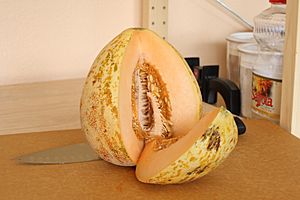Crane Melon facts for kids
Quick facts for kids Crane Melon |
|
|---|---|

Crane Melon
|
|
| Genus | Cucumis |
| Species | melo |
| Breeder | Oliver Crane |
The Crane Melon is a special type of melon known as an heirloom. This means it's an old variety that has been passed down through families for many years. Oliver Crane created this sweet and fruity melon in the early 1900s.
Contents
About the Crane Melon
The Crane Melon was first grown in the early 1900s. This happened in Penngrove, a town close to Santa Rosa, California. Today, you can find and buy these melons at the Crane Melon Barn. This barn is located between Rohnert Park, California and Santa Rosa.
A ripe Crane Melon usually weighs between four and seven pounds. Its inside flesh is a bright orange color.
Why It's Special
The Crane Melon has been featured in many magazines, newspapers, and even on TV shows! It's also listed on the "Ark of Taste" by Slow Food USA. The Ark of Taste is like a special list of unique foods that are important to protect.
Experts consider the Crane Melon a true heirloom. This is because it's a fruit that grows from seeds, and its history goes back more than 50 years.
History of the Melon
The Crane Family
The story of the Crane Melon begins with Richard Hope Crane. He moved from Missouri to California in 1849 during the famous gold rush. In 1852, he settled down in the Santa Rosa area of Sonoma County. The historic Crane Melon Barn, where the melons are still sold, was built in 1868.
How the Melon Was Created
In 1920, Oliver Crane, who was Richard Crane's son, developed the famous Crane Melon. He did this by carefully mixing different types of melons. He used a Japanese melon, a Persian melon, an ambrosia melon, and a white melon.
You won't find Crane Melons in regular grocery stores. They are grown at the Crane Melon Barn and ripen on the vine. This means they are picked when they are perfectly ripe and ready to eat. Because of this, they don't last long enough to be shipped far away. The special taste of the Crane Melon comes from its "terroir." This means the melon's flavor is unique because of the specific soil, climate, and farming style used to grow it.

